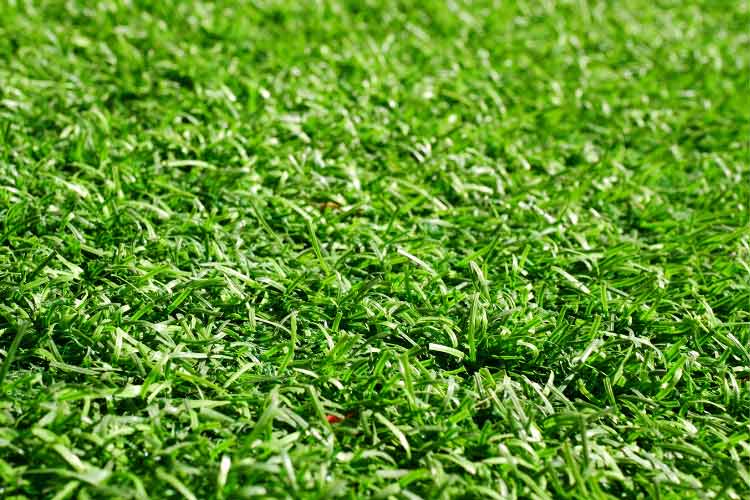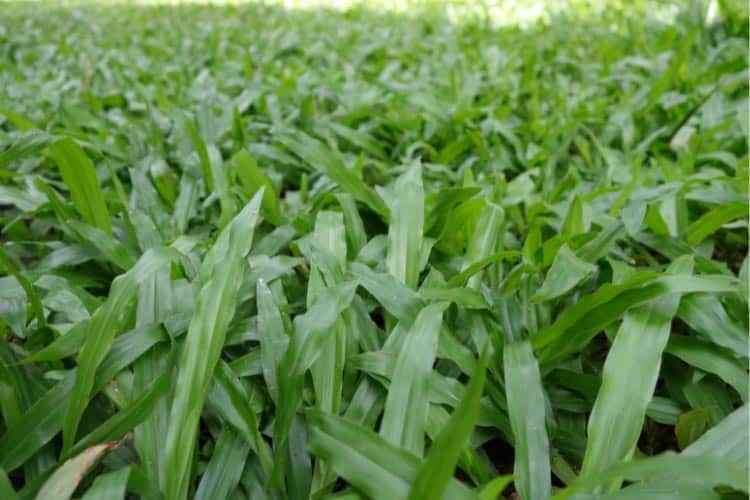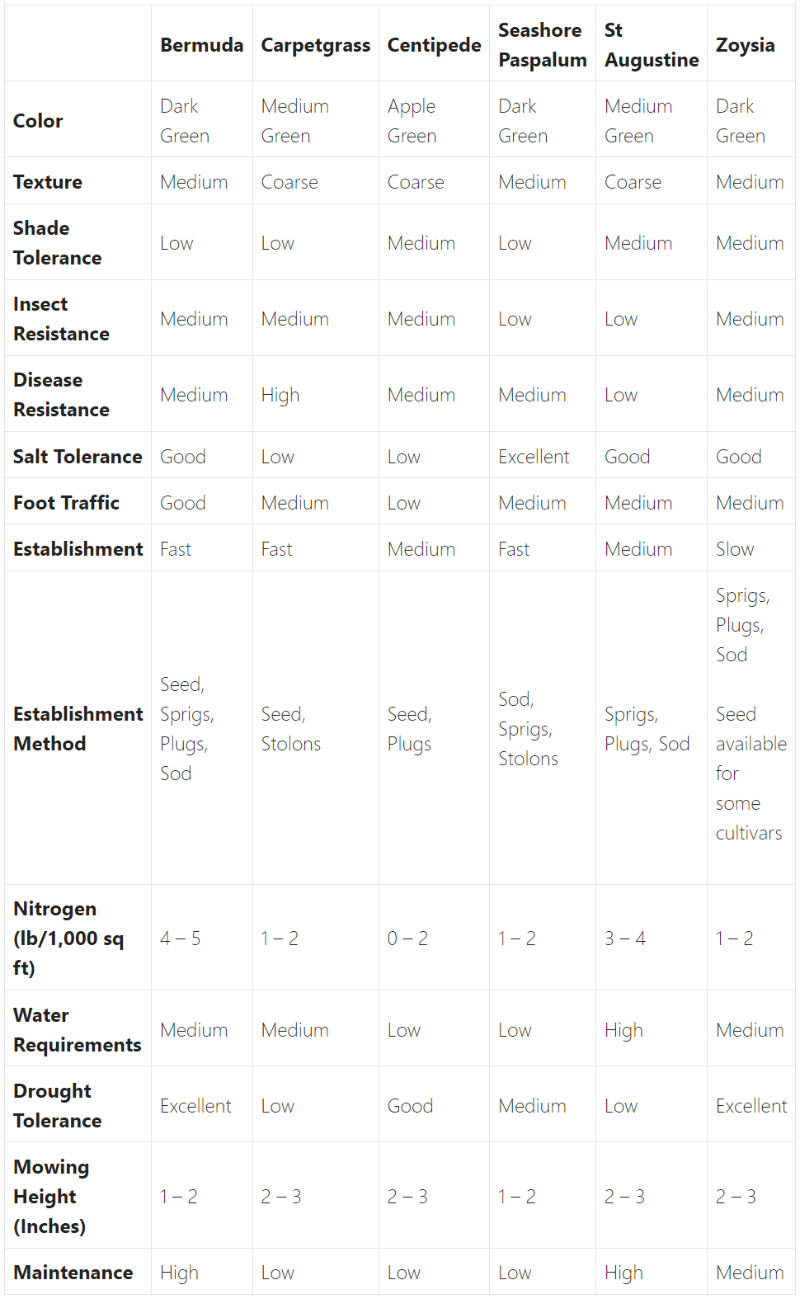While Louisiana has plenty of fertile soil and rainfall, the hot and humid summers can take a toll on your turfgrass, not to mention you, the person out in the heat taking care of it. Picking the right heat-loving grass can help you save time, money, and stress. Which grass is right for your Louisiana lawn? Read on to find out.
What To Know About Grass In Louisiana?
Hot And Humid
While Louisiana enjoys nice weather and mild winters for most of the year, summers are long, hot, and humid.
If you’re not familiar with the Heat Zone Map, it helpfully mirrors the USDA Hardiness Zone Map, but instead of the average minimum winter temperature, it measures the number of days a region gets on average where the temperature climbs to over 86 degrees F. It’s exceedingly useful when gardening or caring for a lawn in Louisiana.
Louisiana stretches across two heat zones, with the northern half in Heat Zone 8 (91 to 120 heat days) and the southern half in Heat Zone 9 (120 to 150 heat days). That’s hot!
Cool-season grasses like Tall Fescue won’t survive. Instead, you’re better off choosing a warm-season grass that thrives on heat and humidity.
As for cold hardiness, those in southern Louisiana in USDA hardiness zone 9 won’t need to worry much. In northern Louisiana in USDA hardiness zone 8, look for a grass with a little more cold hardiness, although heat hardiness will still be a bigger priority.
Irrigation Optional
Most regions in Louisiana get between 50 to 60 inches of rainfall per year, with even the drier regions having a surplus of water. In the summer, frequent thunderstorms turn into intense tropical downpours that may end up flooding your lawn.
This is why the LSU AgCenter rates irrigation as optional or even unnecessary for most of the year (especially October through March). The only time you may need to water your lawn is from June to September, when evapotranspiration (how fast water evaporates from the soil) outclips the rate of rainfall.
You can choose not to water at all through the summer and plant a drought-hardy turfgrass like Bermuda, Seashore Paspalum, or Zoysia. Drought-hardy turfgrasses will go dormant (turn brown) until they get enough water again to perk up. With the frequent downpours, you may not need to wait long at all.
If you choose to irrigate (or sow a turfgrass with little drought tolerance), you’re better off skipping an irrigation schedule and instead only turning the sprinklers on when the grass shows signs of wilting and/or takes on a more grayish or blue-green tinge. By not using a schedule, you’ll take advantage of rainfall, you’ll save majorly on your water bill, and you’ll grow a more resilient lawn, as infrequent irrigation encourages deeper roots. If you have sandy soil, you’ll need to irrigate more frequently.
Fertile Soil
Louisiana has over 300 kinds of soil, grouped in 11 major land resource areas, with 59 soils that hold unique research, historical, and/or cultural significance. But what’s important to you is that most soils found in Louisiana are rich in nutrients. Alluvium soils have high organic matter delivered by one of Louisiana’s many river systems. Loess soils are silty, which are naturally high in minerals.
Most soils are on the acidic side because of all the rainfall Louisiana gets, which gives you a lot of great options for turfgrass. If your soil is very acidic (as found out by a soil test), you’ll need an acid-loving turfgrass.
Soil textures vary greatly from sandy to silt loam to heavy clay. While there’s some ameliorating you can do, it’s best to pick a turfgrass that grows well in your soil texture. To find out what soil texture you have, you can do The Jar Test at home or find your soil through the free SoilWeb app.
It’s always a great idea to get a proper soil test done at a lab when choosing your turfgrass and setting up a fertilizer program – you can find out beforehand what soil and pH level you have, and what nutrients your soil actually needs and what it already has. Excess phosphorus has long-lasting damage that is difficult to correct.
Protecting Waterways
Louisiana’s plethora of bayous, lakes, and rivers are a source of state pride, but in 2020, 90% of these failed to meet water quality standards for wildlife habitat or recreation. Nutrient pollution has even caused a dead zone in the Gulf Coast at the mouth of the Mississippi and Atchafalaya. Nutrient pollution also soaks into groundwater, and nitrates are harmful in drinking water even at low levels.
But you can help. Pesticides, herbicides, and fertilizer used on lawns end up in local waterways from storm runoff or heavy irrigation. Choosing a turfgrass that has low fertilizer requirements and few pest problems can reduce the number of dangerous inputs you need to put on your grass.
And while you can’t do much about intense runoff from severe downpours, you can use sustainable irrigation practices (as advised by the LSU AgCenter above) and switch to organic fertilizers like compost. Growing a rain garden along the runoff path can also give the rain garden plants a chance to soak up the extra nutrients before they reach the storm drain.
Every lawn that makes the switch adds to the impact, so don’t believe that one lawn can’t make a difference. It all adds up!
(Also, don’t replace your lawn with concrete or artificial turf. Concrete radiates heat in an already scorching summer, and artificial turf will release microplastics which are just as harmful as fertilizer, as well as getting really hot.)
6 Types of Grass in Louisiana
1. Bermuda Grass (Cynodon spp.)
Bermuda Grass is one of the most widely grown grasses in Louisiana, and across the subtropical US, as it loves heat, it loves humidity, and it grows like wildfire. Bermuda is also called wiregrass and couchgrass.
Advantages of Bermuda Grass
- Grows an attractive lawn (with maintenance). Except for Zoysia grass, Bermuda grows the most attractive lawn. It’s dark green and you can mow it golf course-short. However, its attractiveness depends on how much work you put into it. Bermuda looks so great on golf courses because they have a team of landscape specialists maintaining it. You can still achieve a great-looking Bermuda lawn without that level of care, but the less you put into it, the less attractive it will look. Be honest about how much time and money you will put into your lawn. A less attractive grass that fits the level of maintenance you can provide will always look better than a neglected lawn.
- Grows aggressively. Bermuda spreads aggressively through both aboveground stolons and belowground rhizomes, especially when it gets intense sunlight. You can establish a new lawn fast from plugs, sprigs, or seed, but it will become your (and your neighbors’) biggest weed as it escapes its bounds.
- Thrives in heat and humidity. Bermuda loves the sweltering Louisiana summers.
- Handles high foot traffic. Bermuda’s a great grass for athletic fields and golf courses, and can handle rough play from kids and dogs.
- Tolerates salt. You can grow it in coastal areas.
- Drought tolerant. While Bermuda has high water needs, it can survive a few weeks without water by going dormant (brown). This means that if you don’t mind the occasional brown lawn, you don’t need to irrigate in the summer when the evapotranspiration rate is higher.
- Tolerates partial submersion underwater. You can plant Bermuda on stream banks or low points, although it does best in well-draining soil.
Disadvantages of Bermuda Grass
- High maintenance. Bermuda requires high amounts of fertilizer and water and as it does best when mowed to 1.5 to 2 inches (and grows rapidly), you will need to mow often. It’s more expensive to maintain.
- Becomes your biggest weed. Rapid growth sounds great in a lawn, until you’re spending your weekends digging out its rhizomes from your surrounding garden beds (not to mention mowing it). Once established, it’s pretty difficult to eradicate. Solarization (placing transparent tarps over the grass for weeks during the heat) can help get rid of a Bermuda lawn, but otherwise you’ll just have to keep it contained.
- Prone to thatch. That rapid growth and high nitrogen needs also means that Bermuda is prone to thatch buildup. The faster it grows (and nitrogen makes it grow faster), the more thatch builds up before it can decompose. You may need to dethatch once or twice a year.
- Low shade tolerance. Bermuda loves the sun. While you can grow Bermuda in light shade during part of the day, the more shade it gets, the more it’ll struggle.
- Struggles in poorly drained soils. While Bermuda can thrive in a wide variety of soils and even tolerate being submerged, it will suffer if it constantly has wet feet.
2. Carpet Grass (Axonopus affinis)
Carpet Grass is a specialist grass – it’s a low maintenance grass that thrives in moist, poor-quality, sandy soil. It’s also called Louisianagrass, as it’s been used as a forage grass in Louisiana for a long time.
Advantages of Carpet Grass
- Thrives in moist, sandy soil. Central Louisiana especially has a lot of acidic, sandy soil. It does well in poor soils.
- Low maintenance. You really get to choose how much maintenance you want to put into it by how often you mow it. If you let it grow naturally, or mow it only a few times a year, then you will only need to fertilize a little (or even not at all). If you mow it weekly to keep it short, then you will need to fertilize it – but much less than Bermuda. Carpet Grass is a good candidate for compost, which has low concentrations of nutrients that resist runoff and feed your lawn for longer.
- Grows into a thick mat to outcompete weeds. Carpet Grass spreads through stolons, and a healthy Carpet Grass lawn will grow thickly and will self-repair.
- Tolerates shade. Carpet Grass grows in both sun and shade.
Disadvantages of Carpet Grass
- Less attractive grass. While it’s not unattractive (it looks similar to both St Augustine and Centipede), it puts up large seed heads during the long Louisiana summers. If you don’t like the look, you may need to mow every 5 to 7 days.
- Medium water needs and low drought-tolerance. While this won’t be a problem for most of the year, if your soil dries out, you will need to irrigate it.
- Poor salt tolerance. While it thrives in moist, sandy soils, iit’s best grown away from the coast.
3. Centipede Grass (Eremochloa ophiuroides)
Like Carpet Grass, Centipede Grass is a low maintenance grass that’s well-adapted to Louisiana. It is in fact probably the lowest maintenance grass you can plant, so long as you don’t treat it like Bermuda.
Advantages of Centipede Grass
- Low maintenance grass. You don’t need to mow often (great for weeks when your lawn never dries out long enough to mow) and requires little to no fertilizer. It has high resistance to both insects and disease. The worst thing you can do for it is to treat it like another turfgrass.
- Thrives in poor quality, sandy, and heavy soil.
- Requires frequent, shallow watering. While its drought tolerance leaves something to be desired, the good news is that it still requires less water than Bermuda. It does best with frequent, shallow waterings.
- Tolerates shade. Centipede grows in both full sun and part shade.
- Few thatch problems. While Centipede grows via stolons (one of the biggest causes of thatch), it grows too slow for thatch buildup to become a problem. Its low fertilizer needs means that fertilizer doesn’t exacerbate the problem.
Disadvantages of Centipede Grass
- Struggles when overfertilized. Whether it’s because people try to fertilize it like a Bermuda lawn as an honest mistake or they over fertilize it to force a darker color, the result is the same – a sickly Centipede lawn. Over fertilization leads to excessive thatch buildup and iron chlorosis (a yellowing that can be mistaken for nitrogen deficiency, so be careful to identify before adding more fertilizer). Over fertilizing is one of the chief causes of Centipede Grass Decline, which will kill your lawn.
- Grows slowly. While there are benefits to its slow growth, it also means it takes much longer to establish a thick lawn. Any damage will take longer to repair (which it can technically do, thanks to its growth via stolons). In the meantime, you will need to weed more often.
- Sensitive to some herbicides. A healthy lawn is always your best defense against weeds, as it should grow thick enough to prevent most weed seeds from germinating. While this is in the disadvantage section, it’s only really a disadvantage if you plan to use herbicides, which could end up in the local waterways.
- Low tolerance to foot traffic. Centipede grows too slowly to recover. It’s best used for lawns that are seen rather than used, or in places out of the way.
4. Seashore Paspalum (Paspalum vaginatum)
If you live along the Gulf Coast and struggle with high salt levels, then check out Seashore Paspalum. It’s also known as sand knotgrass or saltwater cough grass.
Advantages of Seashore Paspalum
- High salt tolerance. Seashore Paspalum really comes through when your biggest challenge is salt and sandy soil. It has the highest salt tolerance of all the grasses (including Bermuda). For a while, some people claimed that you could even water it with ocean water – not true, as eventually you’d build up such high salt levels that even this grass struggles to grow, but it still has a high threshold.
- Low maintenance. You don’t need to trade high salt tolerance for high maintenance. Seashore Paspalum requires little fertilizer and little water. The only thing you really need to do is to mow it frequently – when left long, it’s vulnerable to fungal diseases.
- Highly attractive. When grown in its preferred conditions and the right care, Seashore Paspalum grows a high-quality lawn without as much input as other turfgrasses.
- Low water needs and high drought tolerance. During most of the year, enough water isn’t a problem, but for the hot summer months, when evapotranspiration outpaces rainfall, you won’t need to irrigate.
Disadvantages of Seashore Paspalum
- Needs a low cut (1 to 2 inches tall) to avoid fungal diseases. The ability to mow it really short can be an advantage for growing an attractive golf-course-like lawn, but not so much when you have to mow frequently – and frequent rainfall makes it difficult to get a lawn dry enough to do so. The long, hot summers also means that you’ll need to mow early in the day to avoid heat stroke. If it gets above 2 inches, then Seashore Paspalum becomes prone to fungal diseases, which Louisiana’s high humidity makes worse.
- Struggles against weeds in overfertilized or overwatered soil. In poor, dry soil, Seashore Paspalum excels against weeds because it doesn’t need as much nutrients and water as the weeds. But if you have really fertile soil, or you fertilize more than you need, or you overwater it, or happen to get too much rainfall, the weeds start winning back. Some of this is in your control (fertilizing, watering) and some you can’t (rich soil, rainfall).
- Low resistance to insects. Your best defense against both insects and disease is keeping your lawn as healthy as possible, like by feeding the microbiology in the soil with compost instead of synthetic fertilizer.
- Few safe herbicides. As a newer, less popular turfgrass, there’s not many herbicides on the market that are rated safe to use. Again, growing a thick, healthy lawn and not overfeeding it will cut down on weed problems. Herbicides are best used as spot treatments.
5. St Augustine (Stenotaphrum secundatum)
After Bermuda, St Augustine (also referred to as Charlestongrass) is the most popular grass across the southern US because it likes heat and humidity while tolerating part shade. While it’s adapted to Louisiana, it has many drawbacks.
Advantages of St Augustine
- Tolerates salt and short-term flooding. While not at the level of Seashore Paspalum and Bermuda, St Augustine tolerates salt spray and likes to grow in sandy soil. It will also tolerate flooding, which is vital if you find your yard frequently floods.
- Tolerates part shade. St Augustine grows well in just 4 hours of sun per day.
- Grows into a thick mat that outcompetes weeds once established. It takes some time for it to get established, though, and like other slow growing turfgrasses, will need more care for longer.
Disadvantages of St Augustine
- High maintenance. Between its high nitrogen needs, medium water needs, susceptibility to pests and disease, and high thatch problems, St Augustine needs a lot of care. Like Bermuda, its high nitrogen needs make it more prone to thatch, pests, and disease.
- Poor drought tolerance and medium water needs. You will need to water your St Augustine lawn during the summer when the soil dries out too fast. St Augustine’s roots are too short to give it any drought tolerance.
- Vulnerable to pests and disease. Cultivars Floratam and Floralawn used to have some resistance to chinch bugs, but have lost it as the chinch bugs have adapted. Some cultivars like Floratam, Floralawn, Raleigh, and Seville have resistance to St Augustine Decline, a virus that causes chlorotic mottling on the leaves as it slowly kills the lawn that has no treatment.
- Only available as sprigs, plugs, or sod. If you hoped to save a bit of money by growing a lawn from seed, look elsewhere.
- Sensitive to many common herbicides. Like some other turfgrasses on this list, you need to be careful when selecting a herbicide – or avoid using herbicides altogether. Herbicides are best used as spot treatments.
6. Zoysiagrass (Zoysia spp.)
If you want the most beautiful lawn in your neighborhood and are willing to put in the care, Zoysiagrass is it. Zoysia includes three different species (Zoysia japonica, Z. matrella, and Z. tenuifolia) with dozens of varieties and hybrids that vary in color, texture, establishment, shade tolerance, and more. Zoysia japonica is the most widely used for home lawns, but Z. matrella produces the highest quality lawns matched with the highest maintenance. Z. tenuifolia’s rolling waves are best used as a ground cover instead of a lawn.
Advantages of Zoysiagrass
- Extremely attractive. As noted above, Zoysia is what you go for if you care about having a gorgeous lawn. While the texture and color differs between varieties, Zoysia lawns have a medium to dark green color and medium to fine texture.
- Tolerates shade. Zoysia has great part-shade tolerance, only slightly below St Augustine – but without a research study, you probably won’t notice a difference between the two. Some varieties have higher shade tolerance than others.
- Low water needs and high drought tolerance. Zoysia has very long roots, which gives it excellent drought and heat tolerance. It’s best only watered when it shows signs of wilting and benefits from deep watering.
Disadvantages of Zoysiagrass
- Medium to high maintenance. Zoysia has nitrogen needs on par with St Augustine, and you will need to mow it every 7 to 10 days. You probably won’t need to irrigate it, though, which edges the maintenance down.
- Establishes and recovers slowly. Some cultivars establish faster than others, but you’re looking at an establishment period of 12 to 18 months. If your lawn sees a lot of rugged use, look elsewhere. You can speed up the process by using sod instead of plugs.
- Most cultivars are only available as plugs or sod. Only a few cultivars have seed available, so for the most part, you’re looking at the more expensive plugs and sod.
Warm-Season Grasses For Louisiana Table:
Lawn Alternatives For Louisiana
Ditching the turfgrass lawn altogether has become increasingly popular over the past decade, as homeowners want to get rid of weekends spent mowing the lawn and reduce their lawn’s environmental impact. Ground covers provide an excellent way to keep your lawn green year-round and can grow in places where turfgrass struggles. Louisiana has a ton of lawn alternative options available.
- Powderpuff Mimosa (Mimosa strigillosa). Native to Louisiana, Powderpuff Mimosa is a perennial low-growing, no-mow ground cover that produces pink, ball-shaped flowers that give it its name powderpuff from spring into fall. It has feathery, fern-like foliage that looks fragile but can stand up to light foot traffic. It spreads quickly, has deep roots for erosion control and drought tolerance, and tolerates part shade. The only drawback is that it dies back in the cooler winter months.
- Frogfruit (Phyla nodiflora). Also native to Louisiana, Frogfruit (or Texas Frogfruit) is a low-growing perennial herb with trailing foliage and verbena-like flowers that bloom from March to November. It’s evergreen in places without frost, but in places with cold winters, the leaves take on a reddish or purplish tinge. Frogfruit can grow in any conditions but deep shade: it tolerates both drought and flooding, dry and moist soil, salt and poor drainage.
- Sedge (Carex spp.) If you’d prefer something that looks more like grass, check out Sedges. While they’re not actually grasses, they have green, linear leaves that can look a lot like actual turfgrass from a distance. While there are over 20,000 Sedges to choose from, a few native species adapted to Louisiana include Texas Sedge (Carex texensis), Awlfruit Sedge (Carex stipata), and Fox Sedge (Carex vulpinoidea).
Best Grass Choices For Louisiana Lawns
Pro tip: if you can’t decide between two or three turfgrasses or ground covers, plant a sprig of each in your yard. After 6 weeks, you’ll have a much better idea which one does best in your yard.
| Best Grass For Shade: |
|
| Best Grass For No Irrigation: |
|
| Best Grass For Reducing Fertilizer: |
|
| Best Grass For Low Maintenance: |
|
Read about grass options in other locations:
- 6 Types of Grass in Hawaii (The Ultimate Guide)
- 7 Types of Grass in Colorado
- 10 Types of Grass in California (5 Lawn Alternatives)
- 10 Types of Grass in Arizona (With 3 Lawn Alternatives)
- 9 Types of Grass in Alabama

Jamie is the founder of The Backyard Pros. When he was 15 years old he started working at a garden centre helping people buy plants, gardening products, and lawn care products. He has real estate experience and he is a home owner. Jamie loves backyard projects, refinishing furniture, and enjoys sharing his knowledge online.







